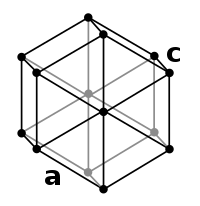
Photo from wikipedia
Highly planar, extended π‐electron organic conjugated polymers have been increasingly attractive for achieving high‐mobility organic semiconductors. In addition to the conventional strategy to construct rigid backbone by covalent bonds, hydrogen… Click to show full abstract
Highly planar, extended π‐electron organic conjugated polymers have been increasingly attractive for achieving high‐mobility organic semiconductors. In addition to the conventional strategy to construct rigid backbone by covalent bonds, hydrogen bond has been employed extensively to increase the planarity and rigidity of polymer via intramolecular noncovalent interactions. This review provides a general summary of high‐mobility semiconducting polymers incorporating hydrogen bonds in field‐effect transistors over recent years. The structural engineering of the hydrogen bond‐containing building blocks and the discussion of theoretical simulation, microstructural characterization, and device performance are covered. Additionally, the effects of the introduction of hydrogen bond on self‐healing, stretchability, chemical sensitivity, and mechanical properties are also discussed. The review aims to help and inspire design of new high‐mobility conjugated polymers with superiority of mechanical flexibility by incorporation of hydrogen bond for the application in flexible electronics.
Journal Title: Advanced Materials
Year Published: 2022
Link to full text (if available)
Share on Social Media: Sign Up to like & get
recommendations!